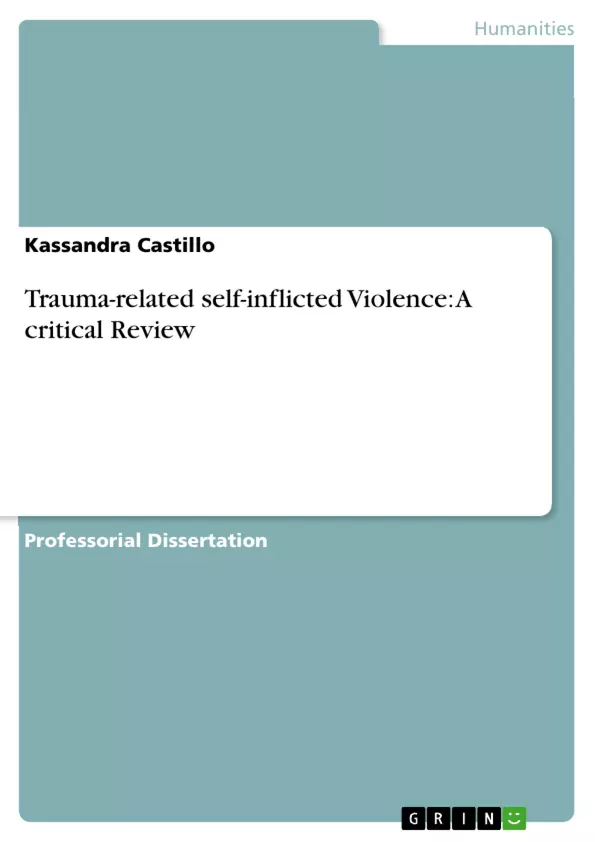This review focuses on several questions such as whether Self Inflicted Violence (SIV) behavior is universally defined in terms of function and meaning; whether literature and research have adequately studied differences in those who engage in Self Inflicted Violence in terms of age, gender, ethnicity, socioeconomic status, education, and sexual orientation; and whether contemporary interventions adequately treat and prevent Self Inflicted behavior.
Table of Contents
- CHAPTER I INTRODUCTION
- Statement of the Problem
- Purpose of the Study
- Significance of the Study
- Scope of the Study
- Definition of Terms
- CHAPTER II METHODOLOGY
- Search Strategy
- Procedures
- CHAPTER III REVIEW OF LITERATURE
- Historical perspective
- Epidemiology
- Risk Factors
- Neurobiological Theories
- Childhood maltreatment
- Methods for SIV
- Motivations for and Functions of SIV
- Concomitant Factors
- Cultural Considerations
- Suicide versus SIV
- Treatment Approaches
- Assessment Measurements
- Summary
Objectives and Key Themes
This study critically reviews existing literature on trauma-related self-inflicted violence (SIV), examining its prevalence, functions, and effective interventions. It aims to increase understanding of SIV behavior, promote multidimensional treatment and prevention approaches, and identify areas for future research. The study addresses gaps in research regarding diverse populations and explores the distinctions between SIV and suicide attempts.
- The relationship between childhood trauma and adult SIV behavior.
- The functions and meanings of SIV across diverse populations.
- The effectiveness of current interventions for SIV.
- The underrepresentation of specific demographics (males, diverse ethnicities, and geriatric populations) in SIV research.
- Differentiating SIV from suicide attempts.
Chapter Summaries
Chapter I: Introduction introduces the complexities of SIV, highlighting the need for a better understanding of this behavior and its underlying causes. It outlines the study's objectives, scope, and key definitions. The statement of the problem underscores the prevalence of SIV, particularly among certain demographics, and the lack of research on specific groups. The purpose of the study establishes its goals: to critically review existing literature, analyze theoretical approaches, and recommend future interventions and research.
Chapter II: Methodology details the search strategy and procedures used to conduct the literature review.
Chapter III: Review of Literature explores the historical perspective of SIV, epidemiological data, risk factors, neurobiological theories, and the role of childhood maltreatment. It examines the methods used for self-inflicted violence, the motivations and functions behind the behavior (emotion regulation, control/punishment, communication), and concomitant factors like cultural considerations. The chapter also discusses the differences between SIV and suicide attempts and reviews various treatment approaches including psychodynamic, cognitive-behavioral, feminist perspectives, and pharmacotherapy.
Keywords
Self-inflicted violence (SIV), trauma, childhood maltreatment, emotion regulation, suicide, intervention, treatment, risk factors, epidemiology, diverse populations, qualitative research, prevention.
- Citar trabajo
- LLB Graduate Kassandra Castillo (Autor), 2008, Trauma-related self-inflicted Violence: A critical Review, Múnich, GRIN Verlag, https://www.grin.com/document/125031



